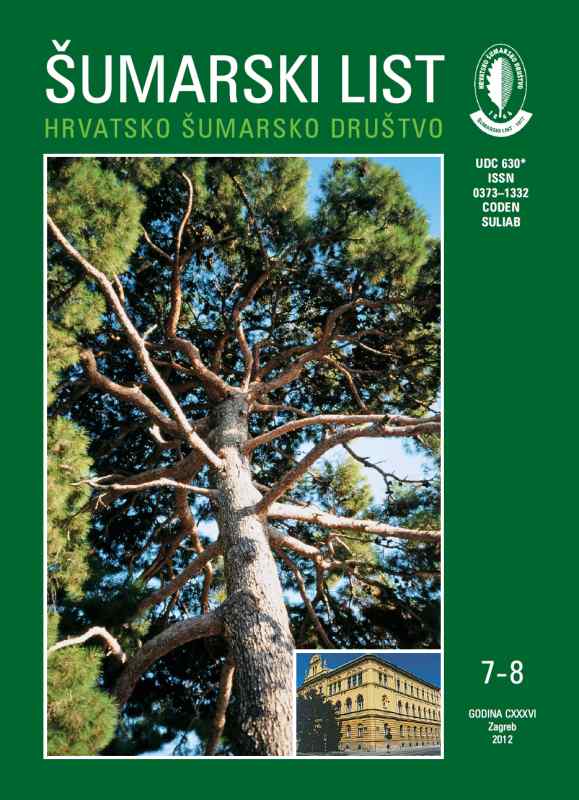
broj: 7-8/2012
pdf (5,5 MB) |
|
||||||||||||||
| RIJEČ UREDNIŠTVA | ||
| Uredništvo | ||
| SOMETHING ABOUT RESTRUCTURING pdf HR EN | 329 | |
| IZVORNI ZNANSTVENI ČLANCI | ||
| Krunoslav Teslak, Jura Čavlović, Mario Božić | UDK 630*624+653 (Pedunculate oak) (001) | |
| The even-aged forest development computer program SIMPLAG: design, structure and application pdf HR EN | 331 | |
| Milan Pernek, Sanja Novak Agbaba, Nikola Lacković, Nikolina Đođ, Ivan Lukić, Stefan Wirth | UDK 630* 165 (001) | |
| The role of biotic factors on pine (Pinus spp.) decline in north Dalmatia pdf HR EN | 343 | |
| SUMMARY In recent years significant decline of pine trees of different species, age, size and position in the forests of Northern Dalmatia has been recorded. This research involves several biotic factors associated with climate extremes, which could cause such harm. In addition to the climate analysis, Pine Processionary Moth, pinewood nematodes, longhorn beetles, bark beetles, needlecast disease caused by fungus were investigated. Results indicate that the mean temperature and precipitation values in the area of Northern Dalmatia deviated significantly from the mid of 2006 to the end of 2008. In this period, extremely high temperatures and severe droughts were recorded. Climatic extremes, especially drought, can be considered the basic adverse factor causing stress and physiological weakening of pine trees and simultaneously improving the conditions for attacks of various types of pests. Favourable conditions caused linking up of adverse factors, the phenomenon has not been explained so far, and it is a possible cause of drying of the crown portions, and sometimes even dieback of individual trees, and more rarely, group of trees. Drought, as a trigger, weakened pines that were subsequently attacked by several species of pathogenic fungi: Lophodermium pinastri, L. seditiosum, Sphaeropsis sapinea, Mycosphaerella pini, Cyclaneusma niveum and Elytroderma torres-juanii. The largest damages were caused by attacks of the fungus S. sapinea. Interferences in normal photosynthesis due to needle shedding have further physiologically deteriorated a tree and it was exposed to attacks of the bark beetle species of Tomicus destruens. It followed by tree diebacks with occurrence of some other species of xylobiont insects (weevils, longhorn beetles). So far it is not possible to determine the scope of impact of wood pathogenic nematodes in the chain of pine dieback without further studies. The first results indicate the presence of several species: Bursaphelenchus mucronatus, B. sexdentati, B. eggersi, of which the two first ones are considered as pathogenic. In addition, nematode vector Monochamus galloprovincialis has been determined which may play an important role in possible occurrence of quarantine species of Bursaphelenchus xylophilus. Key words: Tomicus destruens; Monochamus galloprovincialis; Thaumetopoea pityocampa; Bursaphelenchus spp.; micoses of needles | ||
| Damir Drvodelić, Milan Oršanić, Zoran Zeman | UDK 630*233+232.3 (Pyrus pyraster Burgsd.) (001) | |
| Field performance after reforestation with one year old non-transplanted (1+0) and transplanted (1+1) seedlings of wild pear (Pyrus pyraster Burgsd.) pdf HR EN | 355 | |
| Dinka Matošević, George Melika | UDK 630*442 (001) | |
| Diversity of parasitoid assemblages of native and alien leaf miners in Croatia pdf HR EN | 367 | |
| STRUČNI ČLANCI | ||
| Marija Nodilo | UDK 630*165+907 | |
| Natural heritage of the island of Mljet – the basis of the development of the medical tourism pdf HR EN | 377 | |


